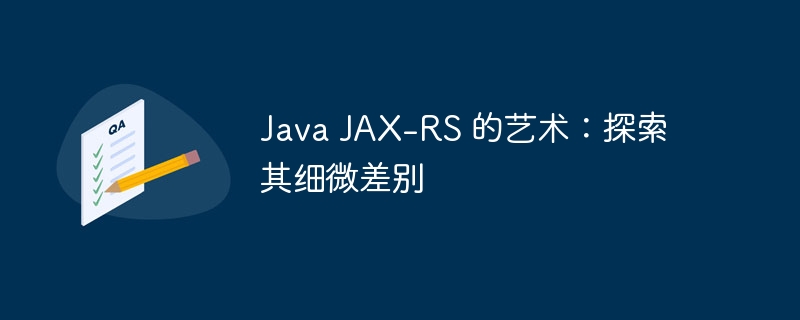

The Art of Java JAX-RS: Exploring Its Nuances Java JAX-RS is an important Java EE specification for building RESTful web services. In practical applications, mastering its nuances is crucial for developers. This article deeply analyzes the technical details of JAX-RS from different angles, discusses its unique features, and helps readers better understand and use this technology. By reading this article, readers will be able to better master the art of Java JAX-RS and improve their skills in the field of RESTful Web service development.
Java api for RESTful WEB Services (JAX-RS) is a Java EE specification designed to simplify the development## of RESTful Web services #. By providing an annotation-driven approach and integrated client support, JAX-RS enables developers to efficiently build and consume RESTful APIs. This article delves into the nuances of JAX-RS, providing code examples and best practices to help developers grasp its power.
Annotation-driven development
JAX-RS adopts an annotation-driven development model and uses Java annotations to mapHttp methods to Java methods. This approach reduces the amount of boilerplate code and allows developers to focus on business logic. The following example shows how to define a simple RESTful endpoint using the @Path and @GET annotations:
@Path("/users")
public class UserService {
@GET
public List<User> getUsers() {
// Fetch users from database
return users;
}
}Client support
In addition to defining server endpoints, JAX-RS also provides client-side support for connecting to and consuming RESTful APIs. By using the @Client and @WebTarget annotations, developers can easily create client proxies to call remote resources. The following example shows how to use ClientBuilder and WebTarget to access a previously defined UserService:
Client client = ClientBuilder.newClient();
WebTarget target = client.target("http://localhost:8080/api");
Response response = target.path("users").request().get();
List<User> users = response.readEntity(new GenericType<List<User>>() {});Resource Mapping
JAX-RS provides powerful resource mapping capabilities, allowing developers to map Java objects to HTTP requests and responses. Developers can control the XML andJSON serialization of objects by using annotations such as @XmlRootElement and @XmlAccessorType. The following example shows how to map a simple User object:
@XmlRootElement
@XmlAccessorType(XmlAccessType.FIELD)
public class User {
private String name;
private int age;
}Media type negotiation
JAX-RS supports media type negotiation, allowing the client to specify the preferred response format. Developers can specify the media types supported by a resource by using the@Produces and @Consumes annotations. The following example shows how to define an endpoint that supports jsON and XML:
@Path("/users")
public class UserService {
@GET
@Produces({"application/json", "application/xml"})
public List<User> getUsers() {
// Fetch users from database
return users;
}
}Error handling
JAX-RS provides a powerful error handling mechanism, allowing developers to handle exceptions and generate custom responses. By using the@ExceptionMapper annotation, developers can map exceptions to custom error responses. The following example shows how to handle NullPointerException and generate a 404 response:
@Provider
@ExceptionMapper(NullPointerException.class)
public class NullPointerExceptionMapper implements ExceptionMapper<NullPointerException> {
@Override
public Response toResponse(NullPointerException exception) {
return Response.status(404).entity("User not found").build();
}
}safety
JAX-RS integrates Java EEsecurity mechanisms to allow developers to protect RESTful APIs. By using the @SecurityContext annotation, developers can access security information, such as the currently authenticated user. The following example shows how to check if the current user has permission to access the endpoint:
@Path("/admin")
public class AdminService {
@GET
@SecurityContext
public void getAdminData(SecurityContext securityContext) {
// Check if the current user has the "ADMIN" role
if (!securityContext.isUserInRole("ADMIN")) {
throw new ForbiddenException();
}
// Fetch and return admin data
}
}Best Practices
Following best practices is critical to building a robust and maintainable JAX-RS API. Here are some best practices:
in conclusion
JAX-RS is a powerfultools set that enables developers to build efficient, maintainable RESTful web services. By gaining a deep understanding of its nuances, developers can take full advantage of its capabilities and create robust and scalable APIs. This article provides a comprehensive overview with code examples and best practices to help developers improve their JAX-RS skills.
The above is the detailed content of The Art of Java JAX-RS: Exploring Its Nuances. For more information, please follow other related articles on the PHP Chinese website!
 What does java routing mean?
What does java routing mean?
 What to do if there is no sound from the computer microphone
What to do if there is no sound from the computer microphone
 What is the difference between php and java
What is the difference between php and java
 What does root server mean?
What does root server mean?
 js string to array
js string to array
 How to buy, sell and trade Bitcoin
How to buy, sell and trade Bitcoin
 Can Douyin sparks be lit again if they have been off for more than three days?
Can Douyin sparks be lit again if they have been off for more than three days?
 What is the difference between USB-C and TYPE-C
What is the difference between USB-C and TYPE-C




